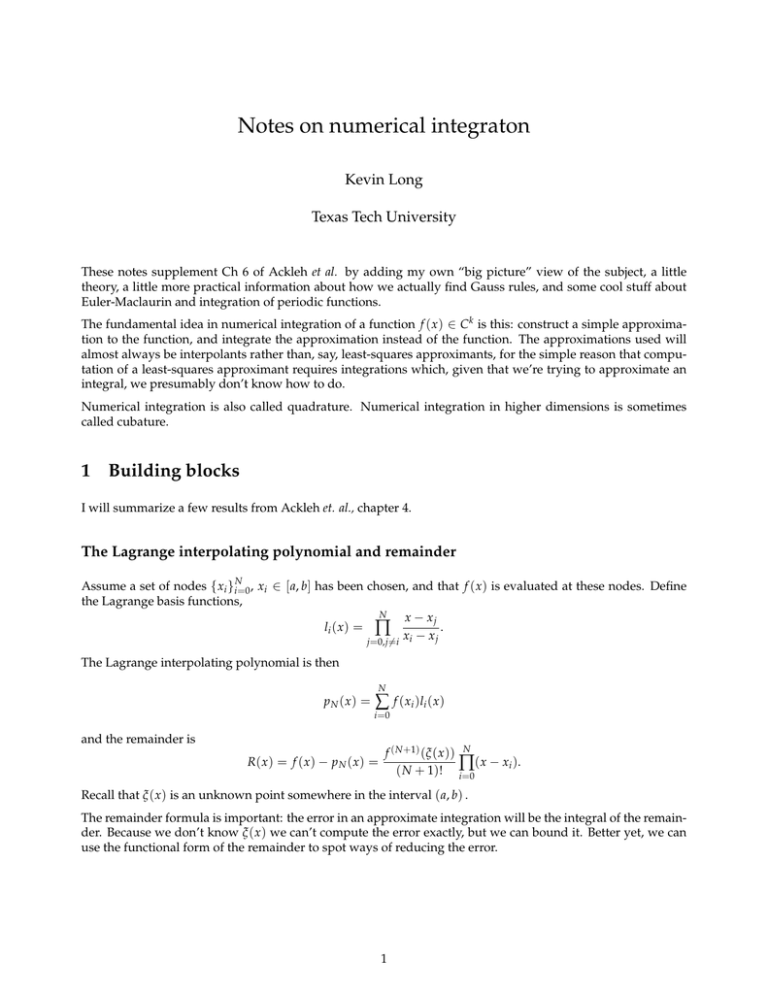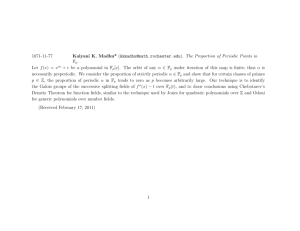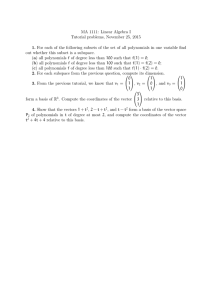Notes on numerical integraton Kevin Long Texas Tech University
advertisement

Notes on numerical integraton
Kevin Long
Texas Tech University
These notes supplement Ch 6 of Ackleh et al. by adding my own “big picture” view of the subject, a little
theory, a little more practical information about how we actually find Gauss rules, and some cool stuff about
Euler-Maclaurin and integration of periodic functions.
The fundamental idea in numerical integration of a function f ( x ) ∈ C k is this: construct a simple approximation to the function, and integrate the approximation instead of the function. The approximations used will
almost always be interpolants rather than, say, least-squares approximants, for the simple reason that computation of a least-squares approximant requires integrations which, given that we’re trying to approximate an
integral, we presumably don’t know how to do.
Numerical integration is also called quadrature. Numerical integration in higher dimensions is sometimes
called cubature.
1
Building blocks
I will summarize a few results from Ackleh et. al., chapter 4.
The Lagrange interpolating polynomial and remainder
Assume a set of nodes { xi }iN=0 , xi ∈ [ a, b] has been chosen, and that f ( x ) is evaluated at these nodes. Define
the Lagrange basis functions,
N
x − xj
li ( x ) = ∏
.
x − xj
j=0,j6=i i
The Lagrange interpolating polynomial is then
N
p N (x) =
∑ f ( x i ) li ( x )
i =0
and the remainder is
R( x ) = f ( x ) − p N ( x ) =
f ( N +1) (ξ ( x ))
( N + 1) !
N
∏ ( x − x i ).
i =0
Recall that ξ ( x ) is an unknown point somewhere in the interval ( a, b) .
The remainder formula is important: the error in an approximate integration will be the integral of the remainder. Because we don’t know ξ ( x ) we can’t compute the error exactly, but we can bound it. Better yet, we can
use the functional form of the remainder to spot ways of reducing the error.
1
The Hermite interpolating polynomial and remainder
Assume a set of nodes { xi }iN=1 , xi ∈ [ a, b] has been chosen, and that f ( x ) and f 0 ( x ) are evaluated at these nodes.
Define the Hermite basis functions,
h
i
0
hi ( x ) = 1 − 2li ( xi )( x − xi ) (li ( x ))2
e
hi ( x ) = ( x − xi ) (li ( x ))2
The Hermite interpolating polynomial is then
N
ηN (x) =
∑
h
f ( xi )hi ( x ) + f 0 ( xi )e
hi ( x )
i
i =1
and the remainder is
N
f (2N ) (ξ ( x ))
R N (x) = f (x) − ηN (x) =
(2N )!
∏ ( x − xi )
!2
.
i =1
As usual, ξ ( x ) is some point in ( a, b).
Comments
• Ackleh et. al. use HN ( x ) for the Hermite interpolating polynomial. However, this leads to confusion with
another (and more important) family of functions, the Hermite polynomials, the n-th member of which
is conventionally denoted Hn ( x ). To make matters worse, there is a quadrature rule (Gauss-Hermite
quadrature) whose analysis uses both families of polynomials named after Charles Hermite. Therefore,
I have used η N ( x ) for the Hermite interpolating polynomials (η is H in the Greek alphabet) and reserve
Hn ( x ) exclusively for the Hermite polynomials.
• Note the difference in starting index: 0 for the Lagrange polynomials, 1 for the Hermite interpolating
polynomials. The functions li ( x ) in the formulas for Hermite interpolation are identical to the Lagrange
basis functions, but indexed from 1 rather than 0.
2
The Big Picture
Some basic terminology
• A quadrature rule is a formula such as
N
QN ( f ) =
∑ wi f ( x i )
i =1
where wi are the weights and xi are the quadrature points, also sometimes called nodes, or (especially in
older books) the abcissas. Note that Ackleh et al use αi for the weights. The notation wi is more common.
Quadrature rules are usually stated on some fixed interval, typically [−1, 1] or [0, 1]. The weights are
normalized so that
Q N (1) =
N
1
i =1
−1
∑ wi · 1 =
1 · dx
(assuming a reference interval [−1, 1]). You then map from the reference interval to the desired interval
[ a, b] by making the affine transformation (assuming a reference interval [−1, 1]),
yi =
a+b b−a
+
xi
2
2
b−a
wi .
2
Instead of memorizing this transformation, learn how to derive it from scratch: you want −1 to map to
b
a, 1 to map to b, and normalize so that your weights vi sum up to a 1 · dx.
vi =
2
• A composite quadrature rule is formed by partitioning [ a, b] into nonoverlapping subintervals
[ a, b] = [ a0 , a N ] = [ a0 , a1 ] ∪ [ a1 , a2 ] ∪ · · · ∪ [ a N −1 , a N ]
and then applying a basic rule on each subinterval. The subintervals need not all have the same length,
but often they will.
• A closed rule has nodes at the endpoints a and b. An open rule does not.
Types of methods
• Newton-Cotes methods were the earliest to be developed, and some are still useful. You might have seen
the simplest NC methods – the midpoint rule, trapezoidal rule, and Simpson’s rule – in your calculus
course. NC methods are easy to use for hand calculations because the nodes are evenly spaced and the
weights are rational numbers. However, Newton-Cotes methods behave badly at higher polynomial
order (for the same reason that interpolants with equally-spaced nodes can be wildly inaccurate) and
so except for the composite rules based on the lowest-order NC methods (basically the three mentioned
previously: midpoint, trapezoidal, and Simpson), Newton-Cotes methods are now largely obsolete. It’s
still worth knowing a little about them because:
– Interestingly, the composite trapezoidal rule proves to be the optimal rule for a small but important
class of functions: the periodic functions.
– NC rules are the starting point for a family of differential equation solvers, the multistep predictorcorrector methods.
– Composite trapezoidal and composite midpoint are the starting points for the Romberg methods,
described below.
– The trapezoidal rule and Simpson’s rule are easy to explain at the undergraduate level, and are a
good recommendation for non-experts
• Gaussian quadrature methods adjust the positions of the nodes, as well as the weights assigned to each
node. Compared to a NC method with the same number of nodes, this results in roughly double the
degree of precision for the same amount of work. Unlike NC methods, Gaussian methods are provably
convergent (for 1D integrals) as order is increased. Historically, the drawbacks had been that the nodes
and weights are more complicated to compute than in a NC rule, and that typically both the nodes and
weights are irrational numbers making hand calculation impractical. There are now efficient methods
for√computing Gauss points and weights, and a computer doesn’t consider an 8-byte approximation to
1/ 3 to be any more complicated than an 8-byte approximation to 4/3. Thus, Gaussian methods are
now a good default choice, robust and accurate for typical quadrature problems. Some other interesting
facts:
– Gaussian methods are (for 1D integrals) closely related to orthogonal polynomials and eigenvalue
problems.
– It is possible to develop Gaussian methods specialized to integrals with certain integrable singularities at the endpoints.
– Gauss points also arise in certain control problems; for example, the optimal location of actuators to
control transverse motion of a beam can be shown to be the Gauss quadrature points.
– Finding Gauss points on tetrahedra and on higher-dimensional simplices (4D domains are used for
problems in general relativity and 6D, 9D, 12D, etc domains are used in quantum chemistry) is an
ongoing research area.
• Richardson extrapolation methods do repeated refinements of a low-order composite rule (trapezoidal or
midpoint) and extrapolate the results to interval size → 0. Comparison of different steps in the refinement sequence can provide on-the-fly error estimates; if you have an accuracy goal, you keep refining
until you either reach the desired accuracy or get tired of waiting for an answer.
3
– The composite trapezoidal rule with Richardson extrapolation is known as the Romberg method.
Romberg quadrature is closely related to an important method for solving ordinary differential
equations, the Bulirsch-Stoer method.
– Romberg methods are based on a theorem, the Euler-Maclaurin summation formula, that is interesting
in its own right. Euler-Maclaurin relates an integral to a finite sum based on iterated integrations by
parts. However, in general the Euler-Maclaurin procedure does not converge as the number of integrations by parts is taken to infinity. This leads to the fruitful concept of an asymptotic sequence: a
sequence of approximations that diverges if taken to the limit, but which can produce a surprisingly
accurate approximation at one of its intermediate steps. You might have seen Stirling’s formula for
the factorial: log(n!) ≈ n log n − n + 21 log(2πn). This very accurate approximation is the start of an
asymptotic series that does not, in fact, converge.
– Certain of the error terms in the Euler-Maclaurin formula vanish identically for integrals of periodic
functions. A proof quickly follows that the composite trapezoidal rule is extremely accurate for
periodic functions.
Some useful methods we won’t cover
You should have heard these names in case you run into a problem for which they are appropriate:
• Gauss-Kronrod methods use variants of Gaussian quadrature rules that are constructed so that a subset
of points re-used through a sequence of refinements. This lets Richardson extrapolation and automatic
error control be used with moderate-order Gauss rules rather than low-order NC.
• Adaptive methods refine differently on different subintervals, refining more on subintervals where the
integration is more difficult. Refinement can be through increasing the number of subintervals while
holding order fixed (called h-refinement) or increasing the order while fixing the subinterval size (called
p-refinement), or a combination of the two (called, you guessed it, hp-refinement).
• Numerical integrals over domains of high spatial dimension are important in many fields including
physics, finance, and reliability engineering. Unfortunately, they are very hard. Monte Carlo methods use
random sampling to deal with the “curse of dimensionality”: the exponential growth in the number of
quadrature points as the dimension of the domain of integration increases. Cleverer variants of the MC
method choose samples from a distribution that is adapted on-the-fly to explore preferentially the parts
of the domain that have been seen to contribute most significantly to the integral.
• Space-filling curve and sparse cubature methods are alternate ways of dealing with the curse of dimensionality. They can converge more rapidly than Monte Carlo. The development of good methods for
approximation of integrals in high dimensional domains is an ongoing research area.
3
Practical calculation of Gauss points
The obvious way to find the Gauss points is to use a numerical root-finding method to compute the zeros of
the Legendre polynomials. A more robust method based on numerical linear algebra was developed by Golub
and Welsch; most calculations now use variants of this method rather than root-finding.
The foundation of the method is the recurrence relation for the Legendre polynomials,
(n + 1) Pn+1 ( x ) = (2n + 1) xPn ( x ) − nPn−1 ( x ).
This formula can be used to compute the Legendre polynomials, as follows. Seed the recurrence with P−1 = 0
and P0 = 1, then
P1 = xP0 − 0 · P−1 = x
2P2 = 3xP1 − P0 = 3x2 − 1
3P3 = 5xP2 − 2P1
4
and so on. This is in fact the most efficient way to compute numerical values of the Legendre polynomials.
In the spirit of taking a simple problem and making it complicated, let’s write this recurrence algorithm as a
linear system of equations for the vector
q( x ) = ( P0 ( x ), P1 ( x ), · · · , PN ( x )) .
Putting the initialization P0 = 1 in the first row and the three-term recurrence in each subsequent row forms a
lower-triangular ( N + 1) × ( N + 1) system of equations
P 1
0
1
P1 0
−x
1
0
P2
1 −3x
2
. .
. .
2
−
5x
3
. .
.
.
=
.
.
. .
. .
N − 2 −(2N − 3) x
N−1
.
.
N−1
−(2N − 1) x N
0
P
N
Solving this system by backsubstitution goes through exactly the same steps as the recurrence; in practice,
you’d simply use the recurrence. The advantage of the linear algebraic formulation becomes clear when we
consider the problem of finding the roots of PN ( x ). If we set PN ( x ) = 0 then we can strike out the last column
from the system. The assignment P0 = 1 in a linear recurrence is arbitrary, so we can also strike out the first
row of equations and let P0 “float” at least temporarily. The resulting N × N equation set is
0
P0
−x
1
..
P1
1 −3x
2
.
2
−
5x
3
=
.
.
.
..
..
.
PN −2 .
−(2N − 3) x
N−1
.
PN −1
N−1
−(2N − 1) x
0
This can be written compactly if we define the tridiagonal matrix A with elements Ai,i+1 = i + 1, Ai+1,i = i + 1
and the diagonal matrix B with elements Bii = 2i + 1 (where indices start with zero). Then the equations are
the generalized eigenvalue problem,
Aq = xBq
which can be turned into an ordinary eigenvalue problem,
B−1 Aq = xq.
Unfortunately, the √
problem’s matrix is no longer symmetric. An improvement is to write the diagonal B as
D T D, where Dii = Bii . Define an auxiliary vector r = Dq so that the eigenvalue problem becomes
AD −1 Dq = xD T Dq
AD −1 r = xD T r
D −T AD −1 r = xr
which is a symmetric eigenvalue problem. With a symmetric formulation all eigenvalues will remain real
even in the presence of roundoff error, making this formulation more suitable for numerical calculation of
high-order quadrature rules.
The eigenvalues x are those points at which PN ( x ) = 0, i.e., the roots we’re looking for. The n-th eigenvector
T
is q( xn ) = P0 ( xn ) P1 ( xn ) · · · PN −2 ( xn ) PN −1 ( xn )
, or the Legendre polynomials evaluated at the
roots. As always in an eigenvalue problem, the eigenvectors are determined only up to a multiplicative constant so we can scale each eigenvector so that P0 ( xn ) = 1, thereby satisfying the first row of equations from the
original system.
5
Calculation of the weights
Having found the Gauss-Legendre points, the weights can be determined by the requirement that each Legendre polynomial P0 through PN −1 be integrated exactly:
(
1
N
2 n=0
∑ wi Pn (xi ) = −1 Pn (x) dx = 0 n > 0 .
i =1
Define Q to be the matrix whose columns are the eigenvectors q, and the weights are obtained by solving the
linear equations
2
w1
w2 0
..
..
=
Q
.
.
.
w N −1 0
0
wN
For this to work, it is important that the eigenvectors be scaled so that each eigenvector has P0 ( xn ) = 1. If not,
the Legendre polynomials at different nodes are scaled by different, effectively random, constants.
Example
We compute the Gauss-Legendre points and weights for N = 4. The matrices A and B are
1 0 0 0
0 1 0 0
0 3 0 0
1 0 2 0
B=
A=
0 0 5 0
0 2 0 3 ,
0 0 0 7
0 0 3 0
and so we must find the eigenvalues and eigenvectors of
D
−T
AD
−1
√1
3
0
√1
3
=
0
0
0
√2
15
0
0
0
√2
15
0
.
0
√3
35
√3
35
0
The points are the eigenvalues, and the weights are obtained by solving Qw = (2, 0, · · · , 0) T . The calculation
must be done numerically. We find the four quadrature points and their weights, to 15 digits:
xi
wi
±0.86113 63115 94053 0.34785 48451 37454
±0.33998 10435 84856 0.65214 51548 62546
Notes
• All of the classical orthogonal polynomials have an associated three-term recurrence relation, so the
Golub-Welsch method generalizes easily to other families of orthogonal polynomials.
• Though this method was first proposed in 1969, it was not widely used until more recently. Why not?
A typical PC in 1989 had 640 KB memory. Finding a 200-point Gauss-Legendre rule in this way requires
storage of a 200×200 matrix in double precision, requiring 320 KB. That’s half of the machine’s memory
just to store the eigenvectors, so the method wasn’t often used in practice. Finding high-order Gauss
rules in those days was therefore usually done by rootfinding, and required careful, robust rootfinding
code to avoid duplicating solutions. Most people used composite Newton-Cotes or composite low-order
Gauss out of convenience. Now that typical computers can easily store and solve the eigenvalue problem,
Golub-Welsch is the simpler choice and can be written in a few lines of Matlab or Mathematica.
6
• The linear solve for the weights can be bypassed by using an identity for Legendre polynomials. See the
literature for this and for various other improvements to the method.
• A C++ implementation for any orthogonal polynomial family is available as part of the open-source
library Trilinos.
4
The Euler-Maclaurin formula
The Euler-Maclaurin formula (EMF) is one of the more remarkable results in classical analysis. It relates integration and discrete summation, and is a source of approximate methods for problems in discrete mathematics
arising in analytic number theory, combinatorics, and theoretical physics.
Approximate summation of series
In this course you’re seeing the EMF in connection with numerical integration, where it is at the heart of both
Romberg integration and the error analysis of the CTR for periodic functions. An equally important use (and
the application for which it was originally developed) is in the numerical summation of series. Suppose you
wanted to compute
∞
1
ζ (2) = ∑ 2 .
n
n =1
2
It can be shown through Fourier analysis that ζ (2) = π6 , and any ζ (2n) can be computed through a similar
method. In Euler’s day, however, the calculation of this sum was a major unsolved problem (known as the
Basel problem). Even today, the exact summation of ζ (2n + 1) is an open problem.
Euler’s idea was to write ζ (2) in two parts,
∞
1
1
+
∑
2
2
n =1 n
n = P +1 n
P
ζ (2) =
∑
where P is small enough so that we can easily compute the first term directly, and to then approximate the
second term by an integral. Use the extended EMF (Theorem 6.4 in Ackleh) with f ( x ) = x −2 to write
∞
dx
P
x2
=
∞
M B
1
1
2j (−2)(−3) · · · (−(2j ))
+ error,
+
+
∑
∑
2P2 n= P+1 n2 j=1 (2j)!
P2j+1
or, after doing the easy integral and ignoring the error term,
∞
M B
1
1
1
2j
=
+
+
∑ P2j+1 (−1) j .
2
P
2P2 n=∑
n
P +1
j =1
We can then write
M (−1) j B
1
1
1
2j
.
+
−
−
∑
2
2
2j+1
P
n
2P
P
n =1
j =1
P
ζ (2) ≈
∑
How well does this work? Let e1 ( P) and e2 ( P) be the error after truncating at P terms with and without the
EMF correction terms (with M = 1). We find
P
e1
10
0.0951663
20
0.0487708
40
0.0246901
0.0124222
80
100
0.009950167
1000 0.000999500
10000 0.000099995
e2
3.30985e − 7
1.03981e − 8
3.25376e − 10
1.01716e − 11
3.333095e − 12
3.333331e − 16
3.333333e − 22
As you can see from the results, a ten-term direct sum corrected by the EMF gives results two orders of magnitude better than a ten thousand term direct sum without correction.
7
Asymptotic approximations
In the preceding calculations, I used M = 1. Would the results have been better had I used a larger M?
Surprisingly, no. The sum of boundary terms in the EMF is an example of an asymptotic series: as M → ∞,
the sum may in fact diverge (and often does for many problems) but nonetheless its partial sums may still give
amazingly good results up to some M.
For a thorough discussion of asymptotic series and how to use them safely, see the book by Bender and Orszag,
Advanced Mathematical Methods for Scientists and Engineers. Applications of asymptotic methods to combinatorics and analysis of algorithms can be found in Knuth’s masterpiece, The Art of Computer Programming:
Volume I, Seminnumerical Methods.
5
Quadrature for periodic functions
The periodic functions are important in applications. A function is T −periodic if, for any x, f ( x + T ) = f ( x ).
Without loss of generality take T = 2π. We want to approximate
2π
f ( x ) dx
0
by quadrature. We will show that the best quadrature method for periodic functions is the composite trapezoidal rule, provided enough points are used to resolve the most significant Fourier modes of the function.
The N-point CTR on [0, 2π ] is
π
2π
π
f (0) + f (2π ) +
QN ( f ) =
N
N
N
N −1
∑
f
n =1
2πn
N
Note that the two endpoints coincide, f (0) = f (2π ), so that
2π
QN ( f ) =
N
N −1
∑
2πn
N
f
n =0
.
The CTR on a periodic function is simply the average of equally-spaced points.
Theorem 1. The N-point CTR on [0, 2π ] is exact for all trigonometric polynomials
τM ( x ) =
M
A0
+ ∑ ( Ak cos(kx ) + Bk sin(kx ))
2
k =1
of maximum frequency M up to N − 1.
Proof. We know that for all k > 0
2π
2π
cos(kx ) dx =
sin(kx ) dx = 0
0
0
and thus for any M,
2π
0
τM ( x ) dx =
A0
.
2
The CTR with any number of points is exact for constants.
Form the error,
2π
EN (τM ) =
0
τM ( x ) dx −
8
2π
N
N −1
∑
n =0
τM
2πn
M
=
=
π
N
2π
N
M N −1 ∑ ∑
Ak cos(
k =0 n =0
M N −1 ∑ ∑
2πkn
2πkn
) + Bk sin(
)
N
N
( Ak + iBk ) e2πink/N + ( Ak − iBk ) e−2πink/N
k =0 n =0
The error will be zero, and thus the CTR will be exact, iff Q N (e±ikx ) = 0 for all k = 1, 2, · · · , M. We therefore
look at the CTR on the complex exponentials,
Q N (e±ikx ) =
2π
N
N −1
∑
e±2πink/N .
n =0
First notice that when k = pN, p ∈ Z, we have e±2πinp = 1 and so Q N (e±ipNx ) = 2π. The CTR is thus not exact
when k = N. For k 6= pN, we notice that Q N is a finite geometric series and so
N
1 − e±2πiNk/N
1 − e±2πik
Q N (e±ikx ) =
=
.
±
2πik/N
2π
1−e
1 − e±2πik/N
The numerator is always zero, and the denominator is nonzero provided k/N ∈
/ Z (that case has already been
dealt with). We have shown that the N-point CTR will be exact for k < N, and will fail to integrate exactly
a term with frequency k = N. We conclude the N-point CTR is exact for trigonometric polynomials up to
maximum frequency N − 1.
Convergence of the CTR for periodic functions
A corrollary to the Weierstrass approximation theorem tells us that any C0 periodic function can be approximated uniformly by trigonometric polynomials. The weights in the CTR are positive, so using an argument
similar to that used to demonstrate convergence of Gaussian quadrature, it can be proved that the CTR is
convergent on C0 periodic functions.
The error in CTR for periodic functions
It is useful to examine the rate of convergence, which can be done using the EMF. The EMF for periodic
functions is interesting because the surface terms in each integration by parts cancel exactly, leaving
2π
2πB2m+2 2π 2m+2 (2m+2)
f ( x ) dx = Q N ( f ) −
f
( ξ ).
(2m + 2)! N
0
Therefore, the error is bounded by
2m+2 2πB
2π
(2m+2) 2m+2
EN ( f ) ≤ f
.
(2m + 2)! N
∞
To simplify, we use an identity due to Euler,
B2n+2 = (−1)n+1
2 (2n + 2)!
(2π )2n+2
where ζ is the Riemann zeta function
ζ (2n + 2)
∞
ζ (2m + 2) =
1
.
2m+2
n
n =1
∑
Clearly for all m > 0, the zeta function is bounded by 1 < ζ (2m + 2) < ζ (2) =
eliminate the Bernoulli number and factorial gives
2m+2 1
(2m+2) EN ( f ) ≤ 2πζ (2m + 2)
f
.
N
∞
We have therefore established:
9
π2
6 .
Using Euler’s identity to
Theorem 2. The error from CTR quadrature of a periodic function f ∈ C2k [0, 2π ], k ≥ 1, is bounded by
EN ( f ) ≤ 2πζ (2k)
1
N
2k (2k) .
f
∞
This is a remarkable result. By contrast, the CTR on a non-periodic C2k function, k ≥ 2, converges as O( N −2 )
regardless of k. For non-periodic functions, the CTR is a moderately efficient, rather robust method, but Gaussian quadrature will usually do better if k is large. For periodic functions, however, the CTR is a very good
method. Unless some other information about f is known (for example, the location of a peak requiring refined quadrature) the CTR is optimal for a periodic function.
What about CTR on periodic C ∞ functions? The error must decrease with N more rapidly than any power
of N, for example, O(e− N ). The determination of the precise form of the dependence of the error on N is not
particularly simple, but an exponential decrease is a good rule of thumb.
Finally, we can use the EMF for an alternate proof of the exactness of the CTR for trigonometric polynomials
of frequency less than N. Consider f ( x ) = cos(kx ). Then f (2m+2) (k) = k2m+2 cos(kx ) and, using the bound
ζ (2k + 2) < ζ (2),
2m+2
k
EN ( f ) ≤ 2πζ (2)
.
N
The cosine is C ∞ , so this bound is true for any m. The best bound will be obtained by finding the m which
minimizes EN . If k < N we can take m → ∞ and find EN → 0. Therefore, the CTR is exact for cosines of
integer frequency less than N. The same argument goes through for sin(kx ), and the theorem for trigonometric
polynomials follows from the linearity of quadrature.
10






